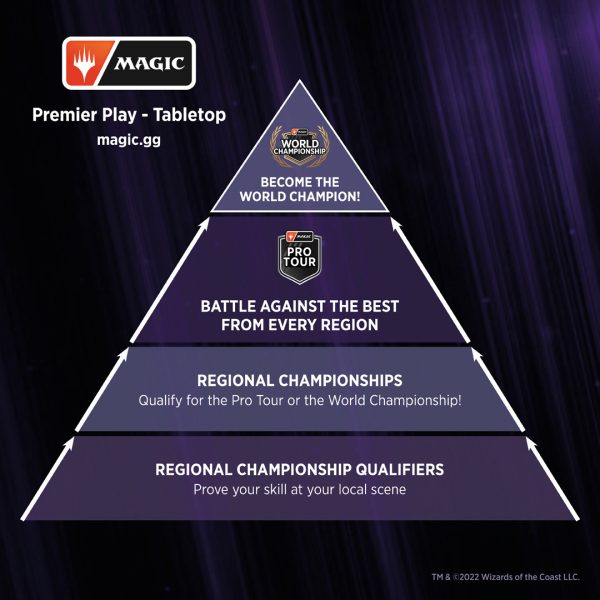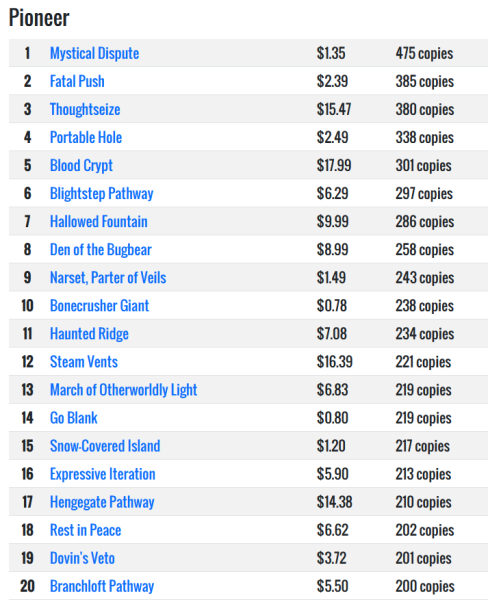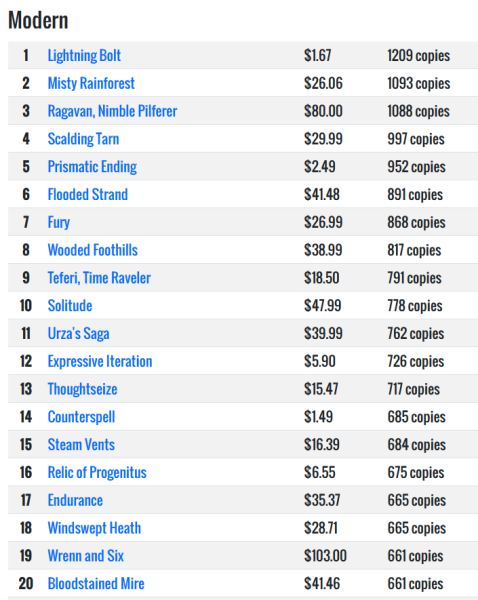Are you a Quiet Speculation member?
If not, now is a perfect time to join up! Our powerful tools, breaking-news analysis, and exclusive Discord channel will make sure you stay up to date and ahead of the curve.
After a couple years of floundering, uncertainty, and general discontent, high level paper Magic play is returning with a flourish! You can check out the announcement on WOTC’s site, here.

With multiple levels of competitive play, there’s a spot for all players to test their skills at Magic—from the regional championship qualifiers at their local game shops, all the way up to the World Championship event. It’s reminiscent of the old system in multiple ways, and that is very much a good thing.
Naturally, this is very exciting news for players. I suspect many preliminary events will evolve around Standard, Pioneer, and possibly Modern. There is once again a reason to actually build and maintain an arsenal of recently printed Magic cards! That means there’s once again hope that a little speculation on certain cards could lead to profits and an overall cost reduction for the game as a whole.
However, before you go rushing around to various online retailers speculating that every card that shows up in a Pioneer decklist will increase in price, take a moment to read through these three important reminders to help guide your buying.
Tip #1: Prioritize the Staples & Multi-format Allstars
I have not read up on the Modern or Legacy metagames lately, so I can’t describe any decklists or strategies that sreally stand out. What I can do, however, is check out data from MTG Stocks to investigate the most played cards in each of those formats. The most popular cards should also see the largest bump in demand and cards that show up on both lists are even more likely to climb due to a sudden surge in demand.


Interestingly enough, there aren’t many cards that appear on both Pioneer’s and Modern’s top 20 list. Without researching anything else, I can tell the two formats must provide very different experiences when playing. That said, there are a couple of key cards I want to hone in on.
First and foremost: lands. Lands lands lands. Namely, mana-fixing, two-colored lands are primary themes across both formats. Fetch Lands dominate in Modern, but in Pioneer you don’t have that option. Shock Lands are available in both formats and show up on both Top 20 lists. Pathways are also viable options, more so in Pioneer than Modern. There are also an array of Fast Lands that may be worth closer examination.
If you want to target some specific cards, I’d keep an eye on Steam Vents, Blood Crypt, Branchloft Pathway, and Botanical Sanctum.
Another card that caught my eye was Thoughtseize, which shows up in the Top 20 of both Modern and Pioneer lists. (It’s also the number 25 most played card in Legacy, though I don’t think Legacy demand is going to move the needle here).
This card has always been a staple no matter what format it’s legal in, so demand for the one mana discard spell is sure to increase as more players get back into paper Magic.
The last thing I’ll highlight is that some of these popular cards have fewer and/or older printings. These in particular may provide greater price upside, even if they aren’t the most played cards in a format. For example, Ragavan, Nimble Pilferer was printed relatively recently but only once at mythic rare, and its Modern demand has driven its price up toward $80. I see Fury is from the same set, also one of the most played Modern cards, yet sells for $27.
Granted, Fury may not be as versatile as Ragavan, but that is a large price differential for two similarly played cards.
A cheaper consideration may be Bonecrusher Giant:
Other than appearing on The List, Throne of Eldraine is this card’s only printing. While it may be just a buck right now, this card proved to be dominant during its time in Standard and it could see a wave of new demand in Pioneer. Throne of Eldraine isn’t that old, but give it a couple years. If this one dodges reprint, it could climb steadily over that time.
Tip #2: Reprint Risk
Speaking of reprints, I was trying to browse the 50 most played Modern cards to find older cards that have never been reprinted. Guess what? There really aren’t any.
Sure, you could argue Teferi, Time Raveler has virtually never been reprinted because the Secret Lair version does little to add to supply. You could also argue that Fury and Ragavan, Nimble Pilferer were never reprinted. I suppose this is true. But Ragavan and Fury were just printed last year, in Modern Horizons 2, so it’s too soon for there to have been a reprint yet. Teferi was printed in War of the Spark, which is a little bit older (released May 2019), but that still not a ton of elapsed time.
The reality is, most format staples are getting the reprint treatment nowadays. That brings me to my second tip: when speculating on staples, be aware of the reprint risk. I’d highly recommend keeping a very narrow horizon on any cards you are buying for potential financial gain. There are frankly a ton of reprint avenues that Wizards has been tapping into in recent years, effectively taking some of that lucrative secondary market for themselves.
Of course that’s their right—it’s their game, after all. I’m not complaining about the reprints, and it does really make the game less expensive for players. It just means the traditional method of speculation on Modern staples is no longer so foolproof.
I’m not saying that Teferi, Time Raveler is a poor speculative target. It’s probably one of my favorites. But it is highly vulnerable to a reprint. As the card ages, it will see an increase in price as more players sleeve up copies for competitive paper Magic. And then one day it’ll show up in some sort of Masters set, or Commander product, or something else, and it’ll halve in price.
Until then, though, I think there’s some money to be made here. Just don’t buy a stack of cards and throw them in a shoebox for a few years—that strategy may not be nearly as lucrative as it once was.
Tip #3: A Rising Tide Lifts All Ships
I’ve discussed this concept multiple times in the past, so I’ll keep this section relatively brief. The basic concept is that, as card prices climb, it inflates the market capitalization of the Magic secondary market. This means player collections naturally rise in price, giving them more purchasing power (i.e. more value for trading).
While many will use this newfound value to trade into tournament staples for the new organized play system, others will instead trade their cards in for Commander staples, Old School favorites, or even Legacy cards. For example, imagine if Teferi, Time Raveler appreciated from $20 to $50 over the next couple years. A playset could suddenly be traded toward a heavily played, Revised Plateau. That could be tempting.
Players who are still cracking booster packs of Modern Horizons 2 may be delighted to open a Ragavan, nearing $100 in price. They may choose to trade it in for Commander cards they’ve been wanting. Remember, the Reserved List is still a thing, and the idea of converting value from modern-day cards into collectibles that can never be reprinted is an attractive notion to some.
Then you can factor in the fact that large, in-person Magic events are probably making a comeback. That gives players a convenient opportunity to cash in some of their cards. If card prices climb due to newfound demand—as many are predicting—then in person events will enable players to trade up for the more expensive staples they’ve been eyeing. While the days of trading in a playset of a Standard staple for a piece of Power are long gone (years ago, a set of Jace, the Mind Sculptors could be traded in for a piece of HP Unlimited Power), one could imagine a world where a Pioneer card set could get you a Dual Land. Or maybe even a Mox Diamond or a Gaea's Cradle. To some, this may be a very attractive proposition.
For this reason, even if you don’t care at all about Pioneer or Modern, you should still be excited for the new Organized Play announcement. Whenever there’s more interest and demand for paper cards, it bodes well for the secondary market as a whole. It may take longer for the effect to trickle up toward Reserved List staples, but it is likely to happen eventually. Unlike newer, reprintable cards, Reserved List cards can be thrown in a closet for a few years for financial reward (it’s one of the things I like most about collecting older cards!). If you’re a passive collector like myself, this could be the best of both worlds.
Wrapping It Up
I’m very excited about the new Organized Play announcement from Wizards of the Coast. The opportunity for players all around the world to compete in person for real cash prizes is very healthy for Magic because it drives up demand for singles. When singles are worth more, then booster packs are more desirable to open. When people open more booster packs, it sells more product for Wizards. In the end, everyone wins.
This is why I expect card prices to climb in the coming months, especially on Pioneer and Modern staples that see the most play. I leveraged MTG Stocks for my list of hot cards, but there are probably other sources with some valuable data. I’d encourage you to tap into those other resources and develop your own strategy for cards to acquire.
My advice is to focus on cards with multi-format demand, and if possible, find cards that haven’t been reprinted a ton. Staples from Modern Horizons and Modern Horizons 2 may be worth focus. Teferi, Time Raveler seems well-positioned. Thoughtseize is a permanent staple in every format. And, of course, lands are always great pickups—especially Shock Lands, Pathways, and Fast Lands.
My only caution is that a narrow time horizon may be required for some of these plays to dodge reprint. Granted, some cards are more likely to avoid near-term reprint than others, and that should be taken into consideration. But Wizards has shown their proclivity for reprinting cards these days, so you can’t just throw cards in a shoebox for a few years and expect every staple to make you money. Diversification can help reduce risk.
Lastly, don’t forget that the rising tide will eventually lift all ships. If you prefer to deal in longer time horizons and don’t want to bother following metagame evolution, you could do a lot worse than to trade your tournament staples into Reserved List Commander cards. Chances are, others will be doing the same thing, meaning prices are likely to continue climbing over time.
No matter how you play the recent news, times should be bright for Magic in the near future. I look forward to a new wave of interest, new players, and new demand as the greatest game ever approaches its third decade of existence!





